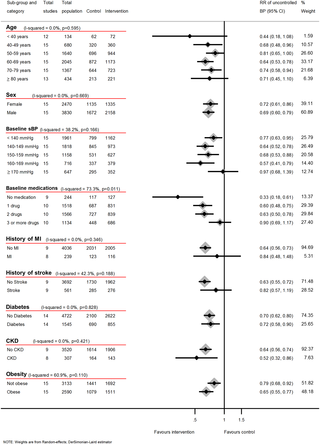PLOS Medicine ( IF 10.5 ) Pub Date : 2017-09-19 , DOI: 10.1371/journal.pmed.1002389 Katherine L. Tucker , James P. Sheppard , Richard Stevens , Hayden B. Bosworth , Alfred Bove , Emma P. Bray , Kenneth Earle , Johnson George , Marshall Godwin , Beverly B. Green , Paul Hebert , F. D. Richard Hobbs , Ilkka Kantola , Sally M. Kerry , Alfonso Leiva , David J. Magid , Jonathan Mant , Karen L. Margolis , Brian McKinstry , Mary Ann McLaughlin , Stefano Omboni , Olugbenga Ogedegbe , Gianfranco Parati , Nashat Qamar , Bahman P. Tabaei , Juha Varis , Willem J. Verberk , Bonnie J. Wakefield , Richard J. McManus

|
Background
Self-monitoring of blood pressure (BP) appears to reduce BP in hypertension but important questions remain regarding effective implementation and which groups may benefit most. This individual patient data (IPD) meta-analysis was performed to better understand the effectiveness of BP self-monitoring to lower BP and control hypertension.
Methods and findings
Medline, Embase, and the Cochrane Library were searched for randomised trials comparing self-monitoring to no self-monitoring in hypertensive patients (June 2016). Two reviewers independently assessed articles for eligibility and the authors of eligible trials were approached requesting IPD. Of 2,846 articles in the initial search, 36 were eligible. IPD were provided from 25 trials, including 1 unpublished study. Data for the primary outcomes—change in mean clinic or ambulatory BP and proportion controlled below target at 12 months—were available from 15/19 possible studies (7,138/8,292 [86%] of randomised participants). Overall, self-monitoring was associated with reduced clinic systolic blood pressure (sBP) compared to usual care at 12 months (−3.2 mmHg, [95% CI −4.9, −1.6 mmHg]). However, this effect was strongly influenced by the intensity of co-intervention ranging from no effect with self-monitoring alone (−1.0 mmHg [−3.3, 1.2]), to a 6.1 mmHg (−9.0, −3.2) reduction when monitoring was combined with intensive support. Self-monitoring was most effective in those with fewer antihypertensive medications and higher baseline sBP up to 170 mmHg. No differences in efficacy were seen by sex or by most comorbidities. Ambulatory BP data at 12 months were available from 4 trials (1,478 patients), which assessed self-monitoring with little or no co-intervention. There was no association between self-monitoring and either lower clinic or ambulatory sBP in this group (clinic −0.2 mmHg [−2.2, 1.8]; ambulatory 1.1 mmHg [−0.3, 2.5]). Results for diastolic blood pressure (dBP) were similar. The main limitation of this work was that significant heterogeneity remained. This was at least in part due to different inclusion criteria, self-monitoring regimes, and target BPs in included studies.
Conclusions
Self-monitoring alone is not associated with lower BP or better control, but in conjunction with co-interventions (including systematic medication titration by doctors, pharmacists, or patients; education; or lifestyle counselling) leads to clinically significant BP reduction which persists for at least 12 months. The implementation of self-monitoring in hypertension should be accompanied by such co-interventions.
中文翻译:

高血压血压自我监测:系统评价和患者个人数据荟萃分析
背景
自我监测血压(BP)似乎可以降低高血压中的BP,但是有关有效实施以及哪些人群可能受益最大的问题仍然很重要。进行此患者数据(IPD)荟萃分析,以更好地了解BP自我监测对降低BP和控制高血压的有效性。
方法和发现
在Medline,Embase和Cochrane库中进行搜索以比较高血压患者的自我监测与无自我监测的随机试验(2016年6月)。两名审稿人独立评估了文章的资格,并与符合条件的试验的作者联系,要求获得IPD。在最初搜索的2846条文章中,有36条符合条件。IPD来自25个试验,包括1个未发表的研究。可从15/19项可能的研究(7,138 / 8,292 [86%]的随机参与者)获得主要结局数据,即平均临床或门诊血压变化以及12个月内控制在目标以下的比例。总体而言,与12个月的常规护理相比,自我监测与临床收缩压(sBP)降低有关(-3.2 mmHg,[95%CI -4.9,-1.6 mmHg])。然而,联合干预的强度严重影响了这种影响,从单独监测的无影响(-1.0 mmHg [-3.3,1.2])到与监测结合使用时减少6.1 mmHg(-9.0,-3.2)的程度。密集的支持。自我监测在使用降压药较少且基线sBP最高至170 mmHg的患者中最为有效。性别或大多数合并症未见疗效差异。可从4个试验(1,478例患者)中获得12个月时的动态BP数据,该试验评估了自我监测的情况,很少或没有共同干预。在这一组中,自我监测与较低的门诊或门诊sBP之间没有关联(门诊为-0.2 mmHg [-2.2,1.8];门诊为1.1 mmHg [-0.3,2.5])。舒张压(dBP)的结果相似。这项工作的主要局限性在于仍然存在明显的异质性。这至少部分归因于纳入研究的不同纳入标准,自我监测机制和目标血压。
结论
单独的自我监测与较低的血压或更好的控制无关,而是与联合干预(包括医生,药剂师或患者的系统性药物滴定;教育或生活方式咨询)结合使用可导致临床上显着的BP降低,并持续至至少12个月。在高血压中实施自我监测应伴有此类联合干预措施。











































 京公网安备 11010802027423号
京公网安备 11010802027423号